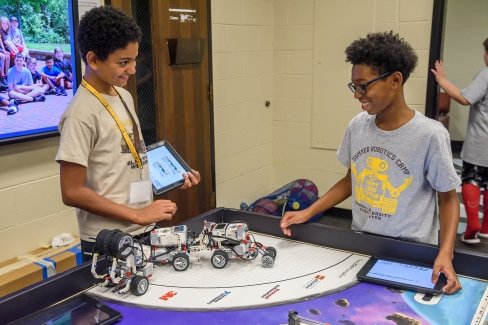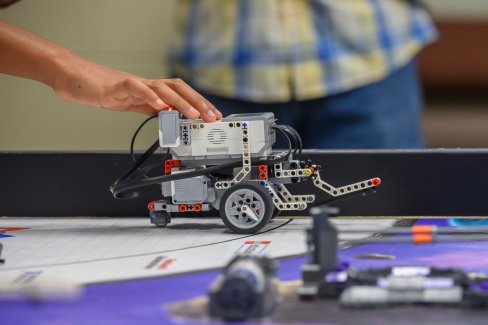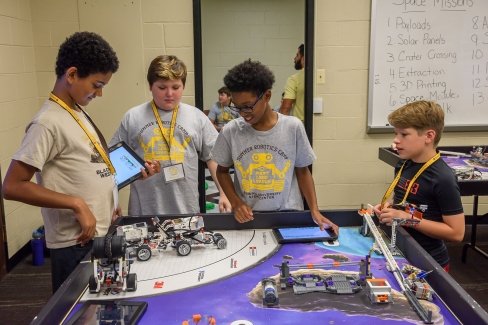Summer STEM and STEAM campers study robotics and more
Summer STEM and STEAM campers study robotics and more
On a recent Friday, groups of students put newly constructed “space rovers” to the test in Robinson Hall.
The students, ages 10 to 14, and their parents observed in silence as the miniature robots navigated obstacles on pool table-sized courses, spurred into action by the press of a button on an iPad. Eleven-year-old Matteo Saggio’s robot harvested “space crops,” 10-year-old Michael Cade’s rover, outfitted with a mallet, triggered a rocket launch.
“One of the things I really liked about camp was I got to meet new people and see what their approach to programming was so I could help them improve and they could help me improve,” Matteo said.
The program was part of Rowan University’s FIRST LEGO League Summer Robotics Camp, a science, technology, engineering, and mathematics (STEM) initiative offered to middle and high school students.
“These kids are learning problem solving and they're not upset when their robot doesn't work,” said STEM Center Program Coordinator Brigid Milone. “They learn how to go back to the drawing board and troubleshoot.”
The STEM Center supports a variety of summer programs in the College of Science and Mathematics such as the Department of Computer Science’s Rowan Academy of Mobile Programming Camp, where students build games for mobile applications, and Rowan’s Innovative Summer Cyber Camp and Workshop, a cybersecurity program for high school students and teachers. In addition, Rowan’s Department of Physics and Astronomy offers ASTRO Camp, an introductory astronomy program for middle school students.
“Parents want to get their kids involved at a young age,” Milone said. “They're looking to continue academics over the summer in a way that engages their children and perhaps exposes them to something new.”
For students who sought a college-level STEM experience with a focus on the arts this summer, Rowan’s competitive STEAM Academy, held for three weeks in July, provided programs for 100 middle and high school students interested in areas like engineering, film, biology, computer programming and music.
In Voyagers, a middle school day camp, students focused on forensics and environmental science. In Navigation, a half-day or full-day program, high school sophomores, juniors, and seniors earned three college credits, completed a research project, and attended career development workshops. Pathways, a residential program for sophomores, juniors, and seniors, enabled students to live in the dorms for a full-college experience, earn three college credits and work alongside Rowan faculty conducting research.
Pairing arts education with STEM disciplines, the STEAM Academy often offers courses that fuse the two, such as the Physics of Human Movement.
“We want to attract students from all backgrounds and interests,” said Melissa Speck, STEAM Academy Program Coordinator. “This year we offered Medical Sculpture and Forensics Reconstruction as it combines both art and science.”
Because course offerings, taught by Rowan faculty, change from year to year, many students return for subsequent summers, some entering college with up to nine transferable college credits.
Since the program’s founding in 2015, about half of the STEAM Academy alumni have gone on to attend Rowan, Speck said.
“It’s really nice to see our students who come back,” she said.



